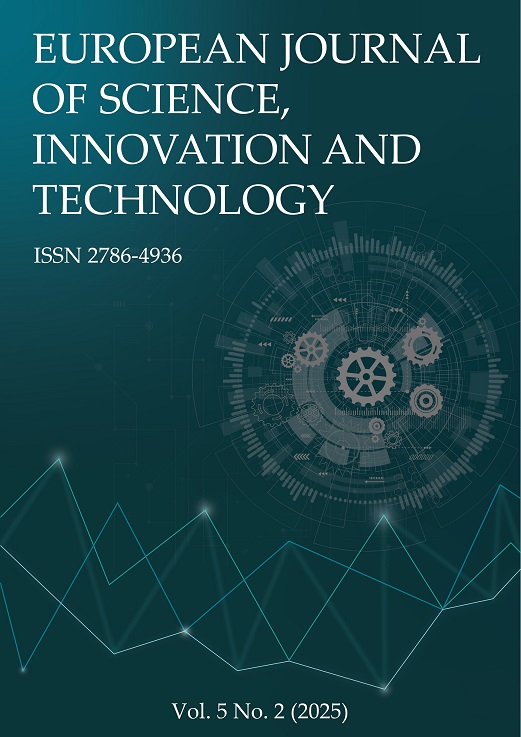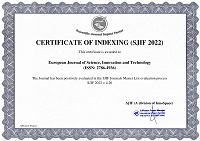Agricultural Land Use Suitability Analysis for Maize Production Using GIS and AHP Techniques in Bali Local Government Area, Taraba State, Nigeria
Abstract
The study assessed agricultural land use suitability for maize production in Bali Local Government Area, Taraba State, using GIS and AHP techniques. It aimed to examine the terrain's physical characteristics, soil physicochemical parameters, spatial variation in soil suitability, and the extent of land suitable for maize production. A descriptive survey design was employed, with a multi-stage sampling approach. Soil samples were collected at 50-meter intervals across nine political wards, air-dried, crushed, and filtered for analysis. Physical and chemical parameters were examined, and the analytic hierarchy process (AHP) was used to determine the relationship between five thematic layers and their attributes. The final suitability classes were analyzed using Weighted Sum Overlay in ArcGIS 10.3 to produce the final suitability map. Results revealed diverse topography with elevations ranging from 112 to 1558 meters, slope variations from 0 to 73.5 degrees, and land surface temperature (LST) ranging from 26.5° to 38.7°. Predominant soil types included Ferric Acrisol, Ferric Luvisols, Fluvisols, Lithosols, and Numic Nitosols, with distinct properties influencing maize cultivation suitability. Nitrogen levels ranged from 0 to 0.2, organic carbon content from 0 to 1.7, and soil depth from 15 to 42 centimeters. Analysis of sand, silt, and clay percentages, textural classes, bulk density, particulate density, and total porosity provided insights into soil structure. Soil type emerged as the most crucial criterion, followed by soil depth and slope. Approximately 50.75% of the land was highly or very highly suitable for maize production. The study recommended integrated land management practices and soil fertility enhancement programs for local farmers and commercial entities.
References
Adesemuyi, E.A (2014). Suitability assessment of soils for maize (Zea mays) production in a humid tropical area of south-western Nigeria. International Journal of Advanced Research, 2(2), 538-546.
Akbari, M., Neamatollahi, E. & Neamatollahi, P. (2019). Evaluating land suitability for spatial planning in arid regions of eastern Iran using fuzzy logic and multi-criteria analysis. Ecol. Indic., 98, 587–598.
Akinci, H., Ozalp, A.Y. & Turgut, Y. (2013). Agricultural land use suitability analysis using GIS and AHP technique. Computers and Electronics in Agriculture, 97, 71–82.
Akpoti, K., Kabo-bah, A.T. & Zwart, S.J. (2019). Agricultural land suitability analysis: State-of-the-art and outlooks for integration of climate change analysis. Agric. Syst., 173, 172–208.
Akram, S. W., Mondal, I. & Bandyopadhyay, J. (2019). Crop suitability analysis in water resource management of Paschim Medinipur District, India: A remote sensing approach. Sustain. Water Resour. Manag., 5(2), 797–815.
Ande, O.T. (2011), “Soil suitability evaluation and management for cassava production in the Derived Savanna area of Southwestern Nigeria”. International Journal of Soil Science, 6(2), 142-149.
Anderson, J. S. & Ingram, J.I.S. (1998). Tropical Soil Biology and Fertility. A Handbook of Methods (2nd ed., pp. 221). Information Press, U.K.
Atiah, W. A., Amekudzi, L. K., Akum, R. A., Quansah, E., Antwi‐Agyei, P., & Danuor, S. K. (2022). Climate variability and impacts on maize (Zea mays) yield in Ghana, West Africa. Quarterly Journal of the Royal Meteorological Society, 148(742), 185-198.
Badu-Apraku, A., Menkir, M.A.B, Fakorede, S. & Ellis-Jones, J. (2012). Building partnerships and encouraging innovation for sustainable maize production: the West and Central Africa Collaborative Maize Research Network, achievements and impact. Ibadan, Nigeria: IITA. 82 pp.
Bagherzadeh, A., Ghadiri, E., Darban, A.R. & Gholizadeh, A. (2016). Land suitability modeling by parametric-based neural networks and fuzzy methods for soybean production in a semi-arid region. Model. Earth Syst. Environ., 2(2), 104. https://doi.org/10.1007/s40808-016-0152-4.
Bako, T., Oparaku, L.A. & Flayin, J.M. (2016). The environmental issues of Taraba State. International Journal of Scientific & Engineering Research, 7(2), 286–294.
Bandyopadhyay, S., Jaiswal, R.K., Hegde, V.S. & Jayaraman, V. (2009). Assessment of land suitability potentials for agriculture using a remote sensing and GIS based approach. Int. J. Remote Sens., 30(4), 879–895.
Baniya, N. (2008). Land suitability evaluation using GIS for vegetable crops in Kathmandu valley/Nepal.
Barakat, A., Ennaji, W., El Jazouli, A., Amediaz, R. & Touhami, F. (2017). Multivariate analysis and GIS-based soil suitability diagnosis for sustainable intensive agriculture in Beni-Moussa irrigated sub-perimeter (Tadla plain, Morocco); Model. Earth Syst. Environ., 3(1), 3.
Baroudy, A.A.E. (2016). Mapping and evaluating land suitability using a GIS-based model. Catena, 140, 96–104.
Bower, C.A. & Wilcox, L.V. (1965). Soluble salts by electrical conductivity. In Black, C.A. (Editor-in Chief), Methods of Soil Analysis Part 2. Chemical and Microbiological Properties (pp. 936-940). American Society of Agronomy, Inc., Published Madison, Wisconsin, USA.
Bozdag, A., Yavuz, F. & Gunay, A.S. (2016). AHP and GIS based land suitability analysis for Cihanbeyli (Turkey) County. Environ. Earth Sci., 75(9), 813.
Burian, J., Stachova, M. & Vondrakova, A. (2018). Land suitability assessment of the Olomouc region: An application of an Urban Planner model. J. Maps, 14(1), 73–80.
Chapman, H.D. (1965). Cation-exchange capacity. Agronomy Monographs, 9, 891-901.
Chen Y., Yu J. & Khan S. (2012) spatial sensitivity analysis of multi-criteria weights in GIS based land suitability evaluation. Environmental Modeling & Software, 25, 1582- 1591.
Chandio, I. A., Matori, A.-N., Lawal, D. U., & Sabri, S. (2011). GIS-based land suitability analysis using AHP for public parks planning in Larkana City. Modern Applied Science, 5, 177.
Cowie, A.L., Orr, B.J., Sanchez, V.M., Chasek, P., Crossman, N.D., Erlewein, A., Louwagie, G., Maron, M., Metternicht, G.I., Minelli, S. & Tengberg, A.E. (2018). Land in balance: The scientific conceptual framework for land degradation neutrality. Environ. Sci. Policy, 79, 25–35.
Dadhich, G., Patel, P.R. & Kalubarme, M.H. (2017). Agriculture land suitability evaluation for wheat cultivation using geomatics for Patan District, India; Int. J. Agric. Resour. Gov. Ecol., 13(1), 91–108.
Dadfar, N. A. (2014). Suitability analysis of a new high school in the city of Calabasas (Doctoral dissertation, California State University, Northridge).
Daneshvar, M.R., Khatami, F. & Shirvani, S. (2017). GIS-based land suitability evaluation for building height construction using an analytical process in the Mashhad city, NE Iran. Model. Earth Syst. Environ., 3(1), 16.
Dedeoğlu, M., & Dengiz, O. (2019). Generating of land suitability index for wheat with hybrid system approach using AHP and GIS. Computers and Electronics in Agriculture, 167, 105062.
Ennaji, W., Barakat, A., El Baghdadi, M., Oumenskou, H., Aadraoui, M., Karroum, L.A. & Hilali, A. (2018). GIS-based multi-criteria land suitability analysis for sustainable agriculture in the northeast area of Tadla plain (Morocco). J. Earth Syst. Sci., 127(6), 79.
ESRI (Economic and Social Research Institute) (2009). GIS best practice: GIS for agriculture. New York: ESRI.
European Space Agency (2023) Copernicus Hub.
Falasca, S.L., Ulberich, A.C. & Ulberich, E. (2012). Developing an agro-climatic zoning model to determine potential production areas for castor bean (Ricinus communis L.). Ind. Crops Prod., 40, 185–191.
Feizizadeh, B. & Blaschke, T. (2013). Land suitability analysis for Tabriz County, Iran: a multi-criteria evaluation approach using GIS. Journal of Environmental Planning and Management, 56(1), 1-23.
Feizizadeh, B., Jankowski, P. & Blaschke, T. (2014). A GIS based spatially-explicit sensitivity and uncertainty analysis approach for multi-criteria decision analysis. Comput. Geosci., 64, 81–95.
FAO-Food Agricultural Organization. (1976). A framework for land evaluation, 11th ed., Food and Agricultural Organization of the United Nations. Rome: FAO, 1-187.
FAO-Food Agricultural Organization. Evaluate land suitability classification. Soils Bulletin No. 32. (1976). http://www.fao.org. Accessed 30 December, 2023.
FAO (1983). Guidelines: Land evaluation for rain-fed agriculture. Soils Bulletin, 52. FAO, Rome, 237 pp.
FAO (1985). Guidelines: Land evaluation for irrigated agriculture. Soil Bulletin, No. 55. Food and Agriculture Organization. Rome. Italy, pp. 229.
FAO-Food Agricultural Organization. (1993). Guidelines for Land-Use Planning. Food and Agriculture Organization of the United Nations: Rome, Italy.
FAO (2007). Land evaluation: towards a revised framework. Rome: Food and Agricultural Organization of the United Nations.
FAO-Food Agricultural Organization. (2007). A Framework for LAND Evaluation. FAO Soil Bulletin No. 6.
FAO-Food Agricultural Organization of the United Nations. (2016). Save and grow in practise maize, rice, wheat. A guide to sustainable cereal production. https://www.fao.org/3/i4009e /i4009e.pdf
FAO-Food Agricultural Organization of the United Nations. (2021). Chemical properties. https://www.fao.org/soils-portal/data-hub/soil-classification/numericalsystems/chemical-properties/en/
Gee, G.W. & Bauder, J.W. (1986). Particle size analysis. In: A. Klute (Ed.), Method of Soil Analysis. Part, 3, 383-411.
Geng, S., Shi, P., Zong, N. & Zhu, W. (2019). Agricultural land suitability of production space in the Taihang Mountains, China. Chinese Geogr. Sci., 29(6), 1024–1038.
Halder, B., Bandyopadhyay, J. & Banik, P. (2020). Assessment of hospital sites’ suitability by spatial information technologies using AHP and GIS-based multi-criteria approach of Rajpur-Sonarpur Municipality. Model. Earth Syst. Environ., 6(4), 2581–2596.
Hamel H. & Dorff E. (2015). Corn: Canada's third most valuable crop. Statistics Canada. https://www150.statcan.gc.ca/n1/pub/96-325-x/2014001/article/11913-eng.htm#n6
Harper, M., Anderson, B., James, P. & Bahaj, A. (2017). Identifying suitable locations for onshore wind turbines using a GIS-MCDA approach; In: 17th International conference on sustainable energy technologies, Bologna, Italy.
Hussien, K., Woldu, G. & Birhanu, S. (2019). A GIS-based multi-criteria land suitability analysis for surface irrigation along the Erer Watershed, Eastern Hararghe Zone, Ethiopia; East Afr. J. Sci., 13(2), 169–184.
International Organisation of Supreme Audit Institution Working Group on Environmental Auditing (2013). 12th Working group meeting of the WGEA in Guilin, Guangxi, China (June 2010). pp. 10.
Jafari, S. & Zaredar, N. (2010). Land Suitability Analysis using Multi Attribute Decision Making Approach. Int. J. Environ. Sci. Dev., 1, 441–445.
Jamil, M., Ahmed, R. & Sajjad, H. (2018). Land suitability assessment for sugarcane cultivation in Bijnor district, India using geographic information system and fuzzy analytical hierarchy process. GeoJournal, 83(7), 595–611.
Jiao, S., Zhang, X. & Xu, Y. (2017). A review of Chinese land suitability assessment from the rainfall-waterlogging perspective: Evidence from the Su Yu Yuan area. J. Clean Prod., 144, 100–106.
Kahsay, A., Haile, M., Gebresamuel, G. & Mohammed, M. (2018a). GIS-based multi-criteria model for land suitability evaluation of rainfed teff crop production in degraded semi-arid highlands of northern Ethiopia; Model. Earth Syst. Environ., 4(4) 1467–1486.
Kazemi, H. & Akinci, H. (2018). A land use suitability model for rainfed farming by Multi-criteria Decision-making Analysis (MCDA) and Geographic Information System (GIS). Ecol. Eng., 116, 1–6.
Kazemi, H., Sadeghi, S. & Akinci, H. (2016). Developing a land evaluation model for faba bean cultivation using geographic information system and multicriteria analysis (A case study: Gonbad-Kavous region, Iran). Ecol. Ind., 63, 37–47.
Keesstra, S.D., Bouma, J., Wallinga, J., Tittonell, P., Smith, P., Cerda, A., Montanarella, L., Quinton, J.N., Pachepsky, Y., Van Der Putten, W.H. & Bardgett, R.D. (2016). The significance of soils and soil science towards realization of the United Nations Sustainable Development Goals. Soil 2(2), 111–128,
Kumar, B.P., Babu, K.R., Rajasekhar, M. & Ramachandra, M. (2019). Assessment of land degradation and desertification due to migration of sand and sand dunes in Beluguppa Mandal of Anantapur district (AP, India), using remote sensing and GIS techniques. J. Ind. Geophys. Union, 23(2), 173–180.
Lawal, B.A., Ojanuga A.G., Noma, S.S., Adeboye, M.K.A., Dikko, A.U & Singh, A. (2012). Suitability Evaluation of Soils of Lower River Oshin Flood plain, Kwara State, Nigeria for Rain-Fed Arable Crop Cultivation. Nigerian Journal of Soil and Environmental Research, 10, 71-78.
Lupia, F. (2014). Crop/Land Suitability Analysis by ArcGIS Tools. Retrieved from https://www.researchgate.net/publication/268517989_crop_land_suitability_analysis_by_arcgistools
Massawe, B. H. J. (2015). Digital Soil Mapping and GIS-based Land Evaluation for Rice Suitability in Kilombero Valley, Tanzania. Thesis for Award of PhD Degree at Ohio State University, United States, pp. 179-241.
Massawe, B.H.J, Kaaya, A.K. & Slater, B. (2019) Involving small holder farmers in the agricultural land use planning process using analytic hierarchy process in rice farming systems of Kilombero Valley, Tanzania. Afr. J. Agric. Res., 14(7), 395–405.
Mendas, A. & Delali, A. (2012). Integration of MultiCriteria Decision Analysis in GIS to develop land suitability for agriculture: application to durum wheat cultivation in the region of Mleta in Algeria. Comput. Electron. Agric., 83, 117–126.
Mesgaran, M.B., Madani, K., Hashemi, H. & Azadi, P. (2017). Iran’s land suitability for agriculture; Sci. Rep., 7, 7670. https://doi.org/10.1038/s41598-017-08066-y
Michael, A. & Chris, P. (2013). A Dictionary of Environment and Conservation, p. 239, ISBN 0199641668.
Mistri, P. & Sengupta, S. (2019). Multi-criteria decision-making approaches to agricultural land suitability classification of Malda District, Eastern India. Nat. Resour. Res., 17, 1–20.
Mohammad, M., Sahebgharani, A. & Malekipour, E. (2013). Urban Growth Simulation Through Cellular Automata (CA), Anaiytic Hierarchy Process (AHP) and GIS; Case Study of 8th and 12th Municipal Districts of Isfahan.
Mousavi, S. R., Sarmadian, F. & Taati, A. (2017). Land suitability evaluation for irrigating wheat by geopedological approach and geographic information system: A case study of Qazvin plain, Iran; Eurasian J. Soil Sci., 6(3), 275.
Musakwa, W. (2018). Identifying land suitable for agricultural land reform using GIS-MCDA in South Africa. Environ. Dev. Sustain., 20(5), 2281–2299.
Mustafa, A.A., Man Singh, R.N., Sahoo, N.A., Manoj, K., Sarangi, A. & Mishra, A.K. (2011). Land Suitability Analysis for Different Crops: A Multi Criteria Decision Making Approach using Remote Sensing and GIS. Researcher, 3(12). http://www.sciencepub.net/ researcher.
Naseer, A. & Pandey, P. (2018). Assessment and monitoring of land degradation using geospatial technology in Bathinda district, Punjab, India. Solid Earth, 9(1), 75–90.
Negi, H.S., Kumar, A., Rao, N.N., Thakur, N.K. & Shekhar, M.S. (2020). Susceptibility assessment of rainfall induced debris flow zones in Ladakh–Nubra region, Indian Himalaya. J. Earth Syst. Sci., 129(1), 1–20.
Nigussie, D., Mulugeta, W., Molla, A., Bishaw, Z. & Biradar, C. (2019). GIS-based multi-criteria land suitability mapping for scaling faba bean varieties in Ethiopia. Afr. Crop Sci. J., 27(4), 687–708.
NIMET (Nigerian Meteorological Agency), (2015). Climate Weather and Water Information, for Sustainable Development and Safety. Abuja: NIMET.
OECD-FAO (2023). Cereals. In Agricultural Outlook 2023-2032.http://dx.doi.org/10.1787/agr-outl-dataen.
Otgonbayar, M., Atzberger, C., Chambers, J., Amarsaikhan, D., Bock, S. & Tsogtbayar, J. (2017). Land Suitability Evaluation for Agricultural Crop land in Mongolia Using the Spatial MCDM Method and AHP Based GIS. Journal of Geoscience and Environment Protection, 5, 238- 263.
Owusu, S., Mul, M. L., Ghansah, B., Osei-Owusu, P. K., Awotwe-Pratt, V. & Kadyampakeni, D. (2017). Assessing land suitability for aquifer storage and recharge in northern Ghana using remote sensing and GIS multi-criteria decision analysis technique. Model. Earth Syst. Environ., 3(4), 1383–1393.
Parry, J. A., Ganaie, S. A. & Bhat, M. S. (2018). GIS based land suitability analysis using AHP model for urban services planning in Srinagar and Jammu urban centers of J&K, India. J. Urban Manag., 7(2), 46–56.
Paul, M., Negahban-Azar, M., Shirmohammadi, A. & Montas, H. (2020). Assessment of agricultural land suitability for irrigation with reclaimed water using geospatial multi-criteria decision analysis; Agric. Water Manag., 231, 105987.
Perveen, F., Nagasawa, R., Uddin, I. & Delowar H.K.M. (2012). “Crop – land suitability analysis using a multicriteria evaluation and GIS approach”, available at: http://www.digitalearthisde.org/cms/upload/Paper%20and%20Abstract/Perveen.pdf (accessed 12/12/2023).
Pramanik, M. K. (2016). Site suitability analysis for agricultural land use of Darjeeling district using AHP and GIS techniques. Model. Earth Syst. Environ., 2(2), 56.
Purnamasari, R. A., Ahamed, T. & Noguchi, R. (2019). Land suitability assessment for cassava production in Indonesia using GIS, remote sensing and multi-criteria analysis. Asia-Pac. J. Reg. Sci., 3(1), 1–32.
Qureshi, M.R., Singh, R.K. & Hasan, M.A. (2018). Decision support model to select crop pattern for sustainable agricultural practices using fuzzy MCDM. Environ. Dev. Sustain., 20(2), 641–659.
Rhoades, J. D. (1982). Soluble salts. In Page, A.L., Miller, R.H. & Keeney, D.R. (Eds.), Methods of soil analysis (Part 2, pp. 167-178). Wisconsin: American Society of Agronomy.
Roy, J. & Saha, S. (2018). Assessment of land suitability for the paddy cultivation using analytical hierarchical process (AHP): A study on Hinglo river basin, Eastern India. Model. Earth Syst. Environ., 4(2), 601–618.
Saaty, T. L. (1990). The Analytic Hierarchy Process. RWS Publications, Pittsburgh, 126pp.
Saaty, T. L. (2014). Analytic Hierarchy Process. Wiley StatsRef: Statistics Reference Online, University of Pittsburgh, Pittsburgh, PA, USA. 14pp.
Saaty, T. & Vargas, L. (2012). Models, methods, concepts & applications of the analytic hierarchy process (2nd ed.). Springer.
Seyedmohammadi, J., Sarmadian, F., Jafarzadeh, A. A. & McDowell, R.W. (2019). Development of a model using matter element, AHP and GIS techniques to assess the suitability of land for agriculture; Geoderma, 352, 80–95.
Sharu, M., Yakubu, M. & Tsafe, A.I. (2013). Characterization and Classification of Soils on an Agricultural landscape in Dingyadi District, Sokoto State, Nigeria. Nigerian Journal of Basic and Applied Sciences, 21(2), 137 -147.
Shehu, A.M. (2018). Land suitability classification for maize production in Basawa, Sabon-gari local government area of Kaduna state, Nigeria. An unpublished M.Sc. Dissertation, Ahmadu Bello University, Zaria.
Shewane, M. A. P., & Khadke, P. A. (2023). Rainfall Variation and Agriculture Landuse. Laxmi Book Publication.
Shobayo, A.B. (2010). A Lithosequence of Soils Developed on Basement Complex Rocks of Zaria, the Northern Guinea Savanna, Nigeria. Unpublished M.Sc., Thesis. Department of Soil Science, ABU, Zaria.
Singha, C. & Swain, K. C. (2016). Land suitability evaluation criteria for agricultural crop selection: A review. Agric. Rev., 37(2), 125–132.
Soil Survey Staff (2014). Keys to Soil Taxonomy 12th Edition. Washington DC: USDA-NRCS.
Tashayo, B., Honarbakhsh, A., Akbari, M., & Eftekhari, M. (2020). Land suitability assessment for maize farming using a GIS-AHP method for a semi-arid region, Iran. Journal of the Saudi Society of Agricultural Sciences, 19(5), 332–338.
Tinguely U. (2012). Suitability Mapping for Jatropha curcas Production in Kenya - A Spatial Modelling Approach. An M.Sc. Theses submitted to Institute of Geography, Department of Integrative Geography Faculty of Natural Sciences University of Bern, Switzerland.
Udoh, B. T. & Ogunkunle, A. O. (2012). Land suitability evaluation for maize (Zea mays) cultivated in a humid tropical area of South-eastern Nigeria. Niger. J. Soil Sci., 22(1), 1- 10.
Ujoh, F., Igbawua, T. & Ogidi, P.M. (2019). Suitability mapping for rice cultivation in Benue State, Nigeria using satellite data. Geo-Spatial Inf. Sci., 22(4), 332–344.
Vasu, D., Srivastava, R., Patil, N.G., Tiwary, P., Chandran, P. & Singh, S.K. (2018). A comparative assessment of land suitability evaluation methods for agricultural land use planning at village level. Land Use Policy, 79, 146–163.
Yalew, S. G., van Griensven, A., Mul, M. L. & van der Zaag, P. (2016a). Land suitability analysis for agriculture in the Abbay basin using remote sensing, GIS and AHP techniques. Model. Earth Syst. Environ., 2(2), 101.
Yalew, S. G., Van Griensven, A. & van der Zaag, P. (2016b). AgriSuit: A web-based GIS-MCDA framework for agricultural land suitability assessment. Comput. Electron. Agric., 128, 1–8.
Yang, M., Wang, G., Ahmed, K.F., Adugna, B., Eggen, M., Atsbeha, E., You, L., Koo, J. & Anagnostou, E., (2020). The role of climate in the trend and variability of Ethiopia's cereal crop yields. Science of the Total Environment, 723, 137893.
Yu, D., Xie, P., Dong, X., Su, B., Hu, X., Wang, K. & Xu, S. (2018). The development of land use planning scenarios based on land suitability and its influences on eco-hydrological responses in the upstream of the Huaihe River basin. Ecol. Model, 373, 53–67.
Zavadskas, E. K., Stevic, Z., Tanackov, I. & Prentkovskis, O. (2018). A novel multicriteria approach – rough step-wise weight assessment ratio analysis method (R-SWARA) and its application in logistics. Stud. Inform. Control, 27(1), 97–106.
Zhang, J., Su, Y., Wu, J. & Liang, H. (2015). GIS based land suitability assessment for tobacco production using AHP and fuzzy set in Shandong province of China. Comput. Electron. Agr., 114, 202–211.
Zolekar, R.B. & Bhagat, V.S. (2015). Multi-criteria land suitability analysis for agriculture in hilly zone: Remote sensing and GIS approach. Comput. Electron. Agr., 118, 300–321.
Copyright (c) 2025 Benjamin Ezekiel Bwadi, John Moses, Mohammed B. Yusuf, Alfred Susan Bala, Queen U. Rimamskep, Favour B. Ezekiel

This work is licensed under a Creative Commons Attribution 4.0 International License.


 ISSN
ISSN 











